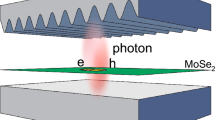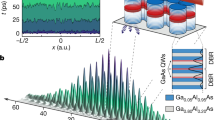Abstract
The Berezinskii–Kosterlitz–Thouless phase transition from a disordered to a quasi-ordered state, mediated by the proliferation of topological defects in two dimensions, governs seemingly remote physical systems ranging from liquid helium, ultracold atoms and superconducting thin films to ensembles of spins. Here we observe such a transition in a short-lived gas of exciton-polaritons, bosonic light–matter particles in semiconductor microcavities. The observed quasi-ordered phase, characteristic for an equilibrium two-dimensional bosonic gas, with a decay of coherence in both spatial and temporal domains with the same algebraic exponent, is reproduced with numerical solutions of stochastic dynamics, proving that the mechanism of pairing of the topological defects (vortices) is responsible for the transition to the algebraic order. This is made possible thanks to long polariton lifetimes in high-quality samples and in a reservoir-free region. Our results show that the joint measurement of coherence both in space and time is required to characterize driven–dissipative phase transitions and enable the investigation of topological ordering in open systems.
This is a preview of subscription content, access via your institution
Access options
Access Nature and 54 other Nature Portfolio journals
Get Nature+, our best-value online-access subscription
$29.99 / 30 days
cancel any time
Subscribe to this journal
Receive 12 print issues and online access
$259.00 per year
only $21.58 per issue
Buy this article
- Purchase on Springer Link
- Instant access to full article PDF
Prices may be subject to local taxes which are calculated during checkout






Similar content being viewed by others
References
Stanley, H. E. Scaling, universality, and renormalization: three pillars of modern critical phenomena. Rev. Mod. Phys. 71, S358–S366 (1999).
Castellano, C., Fortunato, S. & Loreto, V. Statistical physics of social dynamics. Rev. Mod. Phys. 81, 591–646 (2009).
Onsager, L. Crystal statistics. I. A two-dimensional model with an order–disorder transition. Phys. Rev. 65, 117–149 (1944).
Landau, L. D. & Lifshitz, E. M. Statistical Physics Vol. 5 (Butterworth-Heinemann, 1980).
Hohenberg, P. & Halperin, B. Theory of dynamic critical phenomena. Rev. Mod. Phys. 49, 435–479 (1977).
Pitaevskii, L. & Stringari, S. Bose–Einstein Condensation and Superfluidity (Oxford Univ. Press, 2016).
Kohl, M. et al. Criticality and Correlations in Cold Atomic Gases. in Advances in Solid State Physics Vol. 47 (ed. Haug, R.) 79–88 (Springer, 2008); https://link.springer.com/chapter/10.1007/978-3-540-74325-5_7
Braun, S. et al. Emergence of coherence and the dynamics of quantum phase transitions. Proc. Natl Acad. Sci. USA 112, 3641–3646 (2015).
Mermin, N. D. & Wagner, H. Absence of ferromagnetism or antiferromagnetism in one- or two-dimensional isotropic heisenberg models. Phys. Rev. Lett. 17, 1133–1136 (1966).
Minnhagen, P. The two-dimensional coulomb gas, vortex unbinding, and superfluid-superconducting films. Rev. Mod. Phys. 59, 1001–1066 (1987).
Steinhauer, J., Ozeri, R., Katz, N. & Davidson, N. Excitation spectrum of a Bose–Einstein condensate. Phys. Rev. Lett. 88, 120407 (2002).
Nelson, D. R. & Kosterlitz, J. M. Universal jump in the superfluid density of two-dimensional superfluids. Phys. Rev. Lett. 39, 1201–1205 (1977).
Szymanska, M. H., Keeling, J. & Littlewood, P. B. Nonequilibrium quantum condensation in an incoherently pumped dissipative system. Phys. Rev. Lett. 96, 230602 (2006).
Szymańska, M. H., Keeling, J. & Littlewood, P. B. Mean-field theory and fluctuation spectrum of a pumped decaying Bose–Fermi system across the quantum condensation transition. Phys. Rev. B 75, 195331 (2007).
Richard, M., Kasprzak, J., Romestain, R., Andre, R. & Dang, L. S. Spontaneous coherent phase transition of polaritons in CdTe microcavities. Phys. Rev. Lett. 94, 187401 (2005).
Kasprzak, J. et al. Bose–Einstein condensation of exciton polaritons. Nature 443, 409–414 (2006).
Balili, R., Hartwell, V., Snoke, D., Pfeiffer, L. & West, K. Bose–Einstein condensation of microcavity polaritons in a trap. Science 316, 1007–1010 (2007).
Carusotto, I. & Ciuti, C. Quantum fluids of light. Rev. Mod. Phys. 85, 299–366 (2013).
Altman, E., Sieberer, L. M., Chen, L., Diehl, S. & Toner, J. Two-dimensional superfluidity of exciton polaritons requires strong anisotropy. Phys. Rev. X 5, 011017 (2015).
Wachtel, G., Sieberer, L., Diehl, S. & Altman, E. Electrodynamic duality and vortex unbinding in driven–dissipative condensates. Phys. Rev. B 94, 104520 (2016).
Dagvadorj, G. et al. Nonequilibrium phase transition in a two-dimensional driven open quantum system. Phys. Rev. X 5, 041028 (2015).
Utsunomiya, S. et al. Observation of Bogoliubov excitations in exciton-polariton condensates. Nat. Phys. 4, 700–705 (2008).
Kohnle, V. et al. From single particle to superfluid excitations in a dissipative polariton gas. Phys. Rev. Lett. 106, 255302 (2011).
Kohnle, V. et al. Four-wave mixing excitations in a dissipative polariton quantum fluid. Phys. Rev. B 86, 064508 (2012).
Roumpos, G. et al. Power-law decay of the spatial correlation function in exciton-polariton condensates. Proc. Natl Acad. Sci. USA 109, 6467–6472 (2012).
Krizhanovskii, D. N. et al. Dominant effect of polariton-polariton interactions on the coherence of the microcavity optical parametric oscillator. Phys. Rev. Lett. 97, 097402 (2006).
Love, A. P. D. et al. Intrinsic decoherence mechanisms in the microcavity polariton condensate. Phys. Rev. Lett. 101, 067404 (2008).
Kim, S. et al. Coherent polariton laser. Phys. Rev. X 6, 011026 (2016).
Dihel, S. et al. Quantum states and phases in driven open quantum systems with cold atoms. Nat. Phys. 4, 878–883 (2008).
Keeling, J., Szymańska, M. H. & Littlewood, P. B. Keldysh Green’s Function Approach to Coherence in a Non-Equilibrium Steady State: Connecting Bose–Einstein Condensation and Lasing 293–329 (Springer, 2010).
Kirton, P. & Keeling, J. Nonequilibrium model of photon condensation. Phys. Rev. Lett. 111, 100404 (2013).
Deng, H., Weihs, G., Snoke, D., Bloch, J. & Yamamoto, Y. Polariton lasing vs. photon lasing in a semiconductor microcavity. Proc. Natl Acad. Sci. USA 100, 15318–15323 (2003).
Butov, L. V. Solid-state physics: a polariton laser. Nature 447, 540–541 (2007).
Klaers, J., Schmitt, J., Vewinger, F. & Weitz, M. Bose–Einstein condensation of photons in an optical microcavity. Nature 468, 545–548 (2010).
Fraser, M. D., Hofling, S. & Yamamoto, Y. Physics and applications of exciton-polariton lasers. Nat. Mater. 15, 1049–1052 (2016).
Sun, Y. et al. Bose–Einstein condensation of long-lifetime polaritons in thermal equilibrium. Phys. Rev. Lett. 118, 016602 (2017).
Chiocchetta, A. & Carusotto, I. Non-equilibrium quasi-condensates in reduced dimensions. Europhys. Lett. 102, 67007 (2013).
Keeling, J. et al. in Superfluidity and Phase Correlations of Driven Dissipative Condensates (eds Proukakis, N.P., Snoke, D. W. & LIttlewood, P. B.) (Cambridge Univ. Press, 2017).
Krizhanovskii, D. N. et al. Coexisting nonequilibrium condensates with long-range spatial coherence in semiconductor microcavities. Phys. Rev. B 80, 045317 (2009).
Sanvitto, D. et al. Spatial structure and stability of the macroscopically occupied polariton state in the microcavity optical parametric oscillator. Phys. Rev. B 73, 241308(R) (2006).
Deng, H., Solomon, G. S., Hey, R., Ploog, K. H. & Yamamoto, Y. Spatial coherence of a polariton condensate. Phys. Rev. Lett. 99, 126403 (2007).
Nitsche, W. H. et al. Algebraic order and the Berezinskii–Kosterlitz–Thouless transition in an exciton-polariton gas. Phys. Rev. B 90, 205430 (2014).
Hadzibabic, Z. et al. Berezinskii–Kosterlitz–Thouless crossover in a trapped atomic gas. Nature 441, 1118–1121 (2006).
Bajoni, D. et al. Polariton light-emitting diode in a GaAs-based microcavity. Phys. Rev. B 77, 113303 (2008).
Tosi, G. et al. Sculpting oscillators with light within a nonlinear quantum fluid. Nat. Phys. 8, 190–194 (2012).
Wertz, E. et al. Spontaneous formation and optical manipulation of extended polariton condensates. Nat. Phys. 6, 860–864 (2010).
Ballarini, D. et al. Formation of a macroscopically extended polariton condensate without an exciton reservoir. Phys. Rev. Lett. 118, 215301 (2017).
Sieberer, L. M., Buchhold, M. & Diehl, S. Keldysh field theory for driven open quantum systems. Rep. Prog. Phys. 79, 096001 (2016).
Butté, R. et al. Transition from strong to weak coupling and the onset of lasing in semiconductor microcavities. Phys. Rev. B 65, 205310 (2002).
Acknowledgements
This work has been funded by the MIUR project Beyond Nano and the ERC project POLAFLOW (Grant N. 308136). M.H.S. acknowledges support from EPSRC (Grants No. EP/I028900/2 and No. EP/K003623/2).
Author information
Authors and Affiliations
Contributions
D.C. and D.B. took and analysed the data. G.D. and M.H.S. performed stochastical numerical simulations. C.S.M. and F.P.L. discussed the results. D.C., D.B., C.S.M., M.D.G., L.D., G.G., F.P.L., M.H.S. and D.S. co-wrote the manuscript. K.W. and L.N.P. fabricated the sample. D.S. coordinated and supervised all the work.
Corresponding author
Ethics declarations
Competing interests
The authors declare no competing financial interests.
Supplementary information
Supplementary Information
Supplementary Information (PDF 1521 kb)
Rights and permissions
About this article
Cite this article
Caputo, D., Ballarini, D., Dagvadorj, G. et al. Topological order and thermal equilibrium in polariton condensates. Nat. Mater. 17, 145–151 (2018). https://doi.org/10.1038/nmat5039
Received:
Accepted:
Published:
Issue Date:
DOI: https://doi.org/10.1038/nmat5039
This article is cited by
-
Qubit gate operations in elliptically trapped polariton condensates
Scientific Reports (2024)
-
Onset of vortex clustering and inverse energy cascade in dissipative quantum fluids
Nature Photonics (2023)
-
Kardar–Parisi–Zhang universality in a one-dimensional polariton condensate
Nature (2022)
-
Non-equilibrium Bose–Einstein condensation in photonic systems
Nature Reviews Physics (2022)
-
Directional Goldstone waves in polariton condensates close to equilibrium
Nature Communications (2020)



